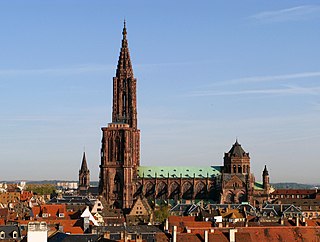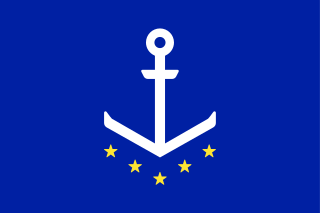
Strasbourg is the prefecture and largest city of the Grand Est region of eastern France, at the border with Germany in the historic region of Alsace. It is the prefecture of the Bas-Rhin department and the official seat of the European Parliament.

Bas-Rhin is a département in Alsace which is a part of the Grand Est super-region of France. The name means 'Lower Rhine', referring to its lower altitude among the two French Rhine departments: it is downstream of the Haut-Rhin department. Both belong to the European Upper Rhine region. It is, with the Haut-Rhin, one of the two departments of the traditional Alsace region which until 1871, also included the area now known as the Territoire de Belfort. The more populous and densely populated of the pair, it had 1,152,662 inhabitants in 2021. The prefecture is based in Strasbourg. The INSEE and Post Code is 67.

The Upper Rhine is the section of the Rhine between the Middle Bridge in Basel, Switzerland, and the Rhine knee in Bingen, Germany. It is surrounded by the Upper Rhine Plain. Most of its upper section marks the France–Germany border.

Kehl is a city with around 38,000 inhabitants in the southwestern German state of Baden-Württemberg. It lies in the region of Baden on the Rhine River, at the confluence with the smaller Kinzig River, directly opposite the French and Alsatian city of Strasbourg. It is the third-largest city of the Ortenaukreis after Offenburg and Lahr/Schwarzwald.

The siege of Strasbourg took place during the Franco-Prussian War, and resulted in the French surrender of the fortress on 28 September 1870.

Lauterbourg is a commune and Bas-Rhin department in the Grand Est administrative region in north-eastern France. Situated on the German border and not far from the German city of Karlsruhe, it is the easternmost commune in Metropolitan France. The German town across the border is Neulauterburg.

The Kinzig is a river in southwestern Germany, a right tributary of the Rhine.

The Central Commission for the Navigation of the Rhine is an international organisation with five member countries, whose function is to encourage European prosperity by guaranteeing a high level of security for navigation of the Rhine and environs. Founded in 1815, it is the world's oldest international organization still in operation. It has been based in Strasbourg, France, since 1920. Lucia Luijten from the Netherlands has been its Secretary General since November 1, 2021.

Souffelweyersheim is a commune in the Bas-Rhin department, Alsace, Grand Est, northeastern France, and is part of metropolitan Strasbourg.

Strasbourg-Ville station is the main railway station in the city of Strasbourg, Bas-Rhin, France. It is the eastern terminus of the Paris-Est–Strasbourg-Ville railway. The current core building, an example of historicist architecture of the Wilhelminian period, replaced a previous station inaugurated in 1852, later turned into a covered market and ultimately demolished.
With nearly 24 million passengers in 2023, Strasbourg-Ville is one of the busiest railway stations in France outside of the Île-de-France.

The Eurodistrict Strasbourg-Ortenau is a Franco-German eurodistrict, a cross-border administrative entity sharing common institutions, established on 17 October 2005 and definitely functional since 4 February 2010. The district is formed by the Eurométropole de Strasbourg, the Communauté de communes du Canton d'Erstein and the French State on the French side of the Rhine and the Ortenau district, comprising the cities of Achern, Kehl, Lahr, Oberkirch and Offenburg, in the Baden-Württemberg region on the German side. The population of the district was roughly 1,000,000 in 2022, and it covers an area of 2,468 km2 (953 sq mi)
Building on regional and Franco-German cooperation, it aims to develop bonds between citizens, associations, public administrations, educational establishments and corporations. It is also in the context of European integration, with the presence of European institutions in Strasbourg, and has been compared to a EU version of Washington D.C.

The siege of Kehl lasted from 26 October 1796 to 9 January 1797. Habsburg and Württemberg regulars numbering 40,000, under the command of Maximilian Anton Karl, Count Baillet de Latour, besieged and captured the French-controlled fortifications at the village of Kehl in the German state of Baden-Durlach. The fortifications at Kehl represented an important bridgehead crossing the Rhine to Strasbourg, an Alsatian city, a French Revolutionary stronghold. This battle was part of the Rhine Campaign of 1796, in the French Revolutionary War of the First Coalition.

At the Battle of Emmendingen, on 19 October 1796, the French Army of Rhin-et-Moselle under Jean Victor Marie Moreau fought the First Coalition Army of the Upper Rhine commanded by Archduke Charles, Duke of Teschen. Emmendingen is located on the Elz River in Baden-Württemberg, Germany, 9 miles (14 km) north of Freiburg im Breisgau. The action occurred during the War of the First Coalition, the first phase of the larger French Revolutionary Wars.

The first railway bridge at Kehl across the Rhine was opened in May 1861. Since then the bridge has been partially or fully destroyed more than once.

The Freiburg–Colmar railway was an international railway that formerly connected Freiburg im Breisgau, in the German state of Baden-Württemberg, with Colmar, in the French department of Haut-Rhin. The line crossed the river Rhine on a bridge between Breisach and Neuf-Brisach. Since that bridge was destroyed in 1945, the line from Freiburg has terminated at Breisach, and this stretch of line is now commonly called the Freiburg–Breisach railway, or the Breisacherbahn. The section from Freiburg to Breisach was completed in 1871 and the remainder in 1878.

During the Battle of Kehl, a Republican French force under the direction of Jean Charles Abbatucci mounted an amphibious crossing of the Rhine River against a defending force of soldiers from the Swabian Circle. In this action of the War of the First Coalition, the French drove the Swabians from their positions in Kehl and subsequently controlled the bridgehead on both sides of the Rhine.

The Second Battle of Kehl occurred on 18 September 1796, when General Franz Petrasch's Austrian and Imperial troops stormed the French-held bridgehead over the Rhine river. The village of Kehl, which is now in the German state of Baden-Württemberg, was then part of Baden-Durlach. Across the river, Strasbourg, an Alsatian city, was a French Revolutionary stronghold. This battle was part of the Rhine Campaign of 1796, in the French Revolutionary War of the First Coalition.

The Battle of Strasbourg Bridge was fought during the Swedish phase of the Thirty Years' War near the Free city of Strasbourg, in the Holy Roman Empire. Having dealt a heavy defeat on the Swedish army at the Battle of Nördlingen in September, the armies of the Emperor, Spain and the Catholic League overran much of the Swedish-held southern Germany. As a result, the Swedish commander, Rheingrave Otto Louis, decided to retreat over the Rhine with his army, using the Strasbourg bridge.

The Place de la République is one of the main squares of the city of Strasbourg, France. It is surrounded on three sides by five buildings only, of which none is residential: the Palais du Rhin, the National and University Library, the Théâtre national de Strasbourg, the Préfecture of Grand Est and Bas-Rhin, and the tax center Hôtel des impôts. All of these buildings are classified as monuments historiques. The fourth side of the square is devoid of buildings.
The Battle of Ortenbach, also known as the Battle of Gengenbach, took place on 23 July 1678 during the closing stages of the 1672-1678 Franco-Dutch War, in the modern German state of Baden-Württemberg. It featured a French army commanded by François de Créquy and an Imperial force under Charles V, Duke of Lorraine.






















